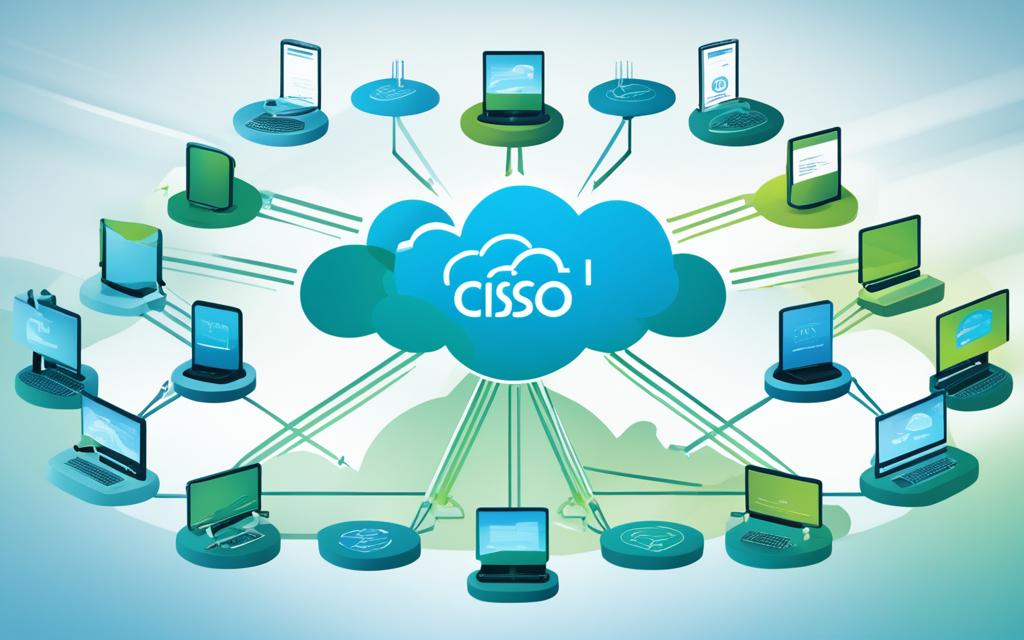Cloud connectivity models have revolutionized the way organizations deploy and manage their networks, offering seamless integration in the ever-evolving digital landscape. These models provide a simplified approach to network management, enabling organizations to scale their networks with ease and optimize their cloud strategy. In this article, we will explore various cloud connectivity models, including Google Cloud’s Network Connectivity Center, Cisco Cloud Network Controller, and Verizon’s multi-cloud options, highlighting their features and benefits for seamless network integration.
Google Cloud’s Network Connectivity Center
Google Cloud’s Network Connectivity Center offers organizations a centralized platform to manage global connectivity. It allows for flexible connectivity across Google Cloud, multicloud, and hybrid networks, providing seamless integration and efficient network operations. With deep visibility into Google Cloud and strong integration with third-party solutions, organizations gain comprehensive insights into their network performance and security.
The Network Connectivity Center supports simplified connectivity, enabling organizations to streamline their network configuration and optimize data transfer over Google’s robust network infrastructure. It also facilitates flexible cloud connectivity, allowing for easy integration of SD-WAN/router appliances and enabling multicloud VPN connectivity. These capabilities enable organizations to create a unified network architecture that seamlessly connects their distributed workloads and resources.
Additionally, the Network Connectivity Center provides deep insights into the global network, empowering organizations to monitor and optimize their network performance. With a centralized management interface, organizations can monitor bandwidth utilization, latency, and other critical network metrics to ensure efficient and reliable network operations.
Use Cases
“Google Cloud’s Network Connectivity Center offers a range of use cases that address diverse networking needs.”
1. Simplified Data Transfer: Organizations can leverage Google Cloud’s high-performance network to simplify and accelerate data transfer between locations, improving overall operational efficiency.
2. SD-WAN/Router Appliance Integration: The Network Connectivity Center simplifies the integration of SD-WAN or router appliances into the network, enabling organizations to optimize their network architecture and enhance performance.
3. Multicloud VPN Connectivity: With the Network Connectivity Center, organizations can establish secure VPN connections between their various cloud environments, ensuring seamless connectivity for their multi-cloud deployments.
Google Cloud’s Network Connectivity Center Benefits
“Google Cloud’s Network Connectivity Center offers several benefits for organizations looking to optimize their network connectivity.”
| Benefits | Description |
|---|---|
| Centralized Management | Organizations can efficiently manage their global connectivity in a single place, simplifying network operations and reducing complexity. |
| Flexible Connectivity | The Network Connectivity Center enables organizations to seamlessly connect their resources across Google Cloud, multicloud, and hybrid networks, providing the flexibility required for agile business operations. |
| Comprehensive Insights | Deep visibility into the network allows organizations to monitor performance metrics, identify bottlenecks, and optimize network operations for improved efficiency. |
| Increase Efficiency | By leveraging Google Cloud’s high-performance network, organizations can streamline data transfer and enhance overall operational efficiency. |
| Enhanced Security | The Network Connectivity Center ensures secure connectivity between locations, protecting data and applications from unauthorized access. |
Cisco Cloud Network Controller
Cisco Cloud Network Controller is a powerful networking tool designed to facilitate seamless network integration across hybrid and multicloud environments. This innovative solution empowers enterprises to broker, connect, build, and govern their networks with ease.
One of the key features of Cisco Cloud Network Controller is its ability to provide seamless connectivity for workloads at scale. Whether it’s connecting multiple locations in a multicloud data-center network or extending on-premises data centers into true multicloud architectures, this tool ensures uninterrupted connectivity to support various deployment models.
Furthermore, Cisco Cloud Network Controller offers operational simplicity and visibility across the entire multicloud data-center network. With a user-friendly interface and comprehensive visibility into network performance, organizations can easily monitor and manage their networks.
Another significant advantage of Cisco Cloud Network Controller is its ease of integration with L4-7 services. This enables organizations to effortlessly incorporate additional services into their network infrastructure, enhancing functionality and meeting specific business requirements.
Security and segmentation are also addressed by Cisco Cloud Network Controller, providing consistent and robust security measures. By implementing Cisco’s advanced security features, organizations can ensure the highest level of data protection and segmentation within their network environment.
Moreover, Cisco Cloud Network Controller offers business continuity and disaster recovery capabilities to safeguard against potential disruptions. This ensures that critical business operations can continue seamlessly, even in the face of unforeseen events.
Overall, Cisco Cloud Network Controller is a comprehensive solution that empowers enterprises to optimize their network performance, enhance security, and streamline their operations in a multicloud environment.

Key Features of Cisco Cloud Network Controller:
- Seamless connectivity for workloads at scale
- Operational simplicity and visibility across multicloud data-center networks
- Easy integration with L4-7 services
- Consistent security and segmentation
- Business continuity and disaster recovery capabilities
Verizon’s Multi-Cloud Options
Verizon offers a comprehensive range of multi-cloud options that empower organizations to simplify and secure their multi-cloud architectures. With a focus on seamless connectivity and global coverage, Verizon’s solutions provide organizations with the flexibility and scalability they need to optimize their cloud strategy. These multi-cloud options include:
- NaaS Cloud Management
- Secure Cloud Interconnect (SCI)
- Software Defined Interconnect (SDI)
- Additional services
Verizon’s multi-cloud options offer several key advantages for organizations:
- Seamless Connectivity: Verizon’s solutions ensure uninterrupted connectivity between various cloud environments, providing organizations with a reliable and consistent network experience.
- Multi-Cloud Orchestration: The ability to manage and orchestrate multiple cloud environments from a central console simplifies the complexity of managing diverse cloud architectures.
- Global Coverage: Verizon’s multi-cloud options offer extensive global coverage, enabling organizations to connect and manage their cloud resources across different regions.
- Quick Deployment: These solutions can be rapidly deployed, allowing organizations to accelerate their cloud initiatives and take advantage of the benefits of multi-cloud environments.
- Consumption-Based Pricing: Verizon’s solutions support consumption-based pricing models, providing organizations with cost-effective options based on their actual usage.
- Reduced Overhead: By partnering with Verizon, organizations can reduce the need for additional overhead and specialized cloud knowledge, streamlining their cloud operations.
By leveraging Verizon’s multi-cloud options, organizations can easily manage their network connections and application traffic, enabling seamless integration and optimized performance across their multi-cloud infrastructure.
“Verizon’s multi-cloud options provide organizations with the flexibility and scalability they need to optimize their cloud strategy.”
| Advantages | Description |
|---|---|
| Seamless Connectivity | Ensures uninterrupted connectivity between different cloud environments. |
| Multi-Cloud Orchestration | Centralized management and orchestration of multiple cloud environments. |
| Global Coverage | Extensive reach and coverage for cloud resources across different regions. |
| Quick Deployment | Rapid deployment to accelerate cloud initiatives. |
| Consumption-Based Pricing | Cost-effective options based on actual usage. |
| Reduced Overhead | Minimized need for additional overhead and specialized cloud knowledge. |
Benefits of Cloud Connectivity Models
Cloud Connectivity Models offer several benefits for organizations. They provide simplified network management, flexible connectivity options, deep visibility into the network, enhanced security, and the ability to connect and consume multiple cloud service providers. These advantages can greatly improve the efficiency and effectiveness of an organization’s network infrastructure.
Simplified Network Management
Cloud Connectivity Models streamline network management processes by centralizing control and providing a unified interface for managing connectivity across various cloud environments. This simplification eliminates the need for organizations to individually manage each network connection, reducing complexity and saving valuable time and resources.
Flexible Connectivity Options
Cloud Connectivity Models enable organizations to choose from a wide range of connectivity options, including virtual private networks (VPNs), direct peering, and dedicated connections. This flexibility allows organizations to tailor their network connectivity to meet their specific needs, whether it’s establishing private connections for enhanced security or optimizing performance through direct peering.
Deep Visibility into the Network
Cloud Connectivity Models provide organizations with comprehensive visibility into their network infrastructure, allowing them to monitor and analyze network traffic, performance metrics, and security threats. This deep visibility enables proactive network management, quick issue resolution, and optimization of network resources.
Enhanced Security
With Cloud Connectivity Models, organizations can implement robust security measures to protect their network and data. These models offer features such as encrypted connections, access controls, and network segmentation, ensuring that sensitive information remains secure from unauthorized access and attacks.
Connectivity with Multiple Cloud Service Providers
Cloud Connectivity Models enable organizations to connect and consume services from multiple cloud service providers, facilitating a multicloud strategy. This flexibility allows organizations to leverage the unique capabilities of different cloud providers, optimize costs, and avoid vendor lock-in.
Accelerated Deployment and Automation
Cloud Connectivity Models leverage cloud-native constructs and automation capabilities to accelerate infrastructure deployment, governance, and management. Organizations can leverage pre-built templates, APIs, and orchestration tools to streamline the provisioning and configuration of network resources, reducing manual effort and enabling faster time-to-value.
Microsegmentation for Enhanced Security
Cloud Connectivity Models support microsegmentation, allowing organizations to create isolated network segments to enhance security. By segmenting the network into smaller zones, organizations can minimize the impact of security breaches, control access between different segments, and apply specific security policies based on individual requirements.
Consistent Operating Model
Cloud Connectivity Models provide a consistent operating model for both on-premises and cloud environments. This standardization simplifies network management, reduces the complexity of managing multiple environments, and improves operational efficiency by ensuring a consistent experience across the entire network infrastructure.
Cloud Connectivity Models offer organizations a wide range of benefits, from simplified network management and enhanced security to flexible connectivity options and deep visibility into the network. By leveraging these models, organizations can optimize their network infrastructure, improve performance, and effectively navigate the complexities of a multicloud environment.
Conclusion
In conclusion, Cloud Connectivity Models play a vital role in optimizing network performance and integration in a multicloud environment. Google Cloud’s Network Connectivity Center, Cisco Cloud Network Controller, and Verizon’s multi-cloud options offer robust solutions for seamless network integration. By leveraging these models, organizations can streamline their cloud strategy, enhance network performance, and improve overall operational efficiency.
It is crucial for businesses to explore and adopt the right cloud connectivity models to adapt to the evolving needs of the digital landscape. These models provide simplified network management, flexible connectivity options, deep visibility into the network, enhanced security, and the ability to connect and consume multiple cloud service providers.
With cloud-native constructs and automation capabilities, Cloud Connectivity Models enable organizations to accelerate infrastructure deployment, governance, and management. They also support microsegmentation for enhanced security and provide a consistent operating model for both on-premises and cloud environments. By embracing these models, organizations can optimize their cloud deployments and maximize their network performance.
FAQ
What are Cloud Connectivity Models?
Cloud Connectivity Models are solutions that enable organizations to deploy, manage, and scale their networks with ease, providing seamless integration across multiple cloud environments.
What is Google Cloud’s Network Connectivity Center?
Google Cloud’s Network Connectivity Center is a cloud connectivity solution that offers a single place to manage global connectivity. It enables flexible connectivity across Google Cloud, multicloud, and hybrid networks, with deep visibility and integration with third-party solutions.
What does Cisco Cloud Network Controller do?
Cisco Cloud Network Controller is a networking tool that allows enterprises to connect and govern their networks across hybrid and multicloud environments. It provides seamless connectivity for workloads, operational simplicity, easy L4-7 services integration, consistent security, and business continuity.
What are Verizon’s Multi-Cloud Options?
Verizon offers fully managed and self-managed multi-cloud options for organizations to simplify and secure their multi-cloud architectures. These options include NaaS Cloud Management, Secure Cloud Interconnect (SCI), Software Defined Interconnect (SDI), and additional services.
What are the benefits of Cloud Connectivity Models?
Cloud Connectivity Models provide simplified network management, flexible connectivity options, deep visibility into the network, enhanced security, and the ability to connect and consume multiple cloud service providers. They also accelerate infrastructure deployment, support microsegmentation, and provide a consistent operating model for on-premises and cloud environments.



















